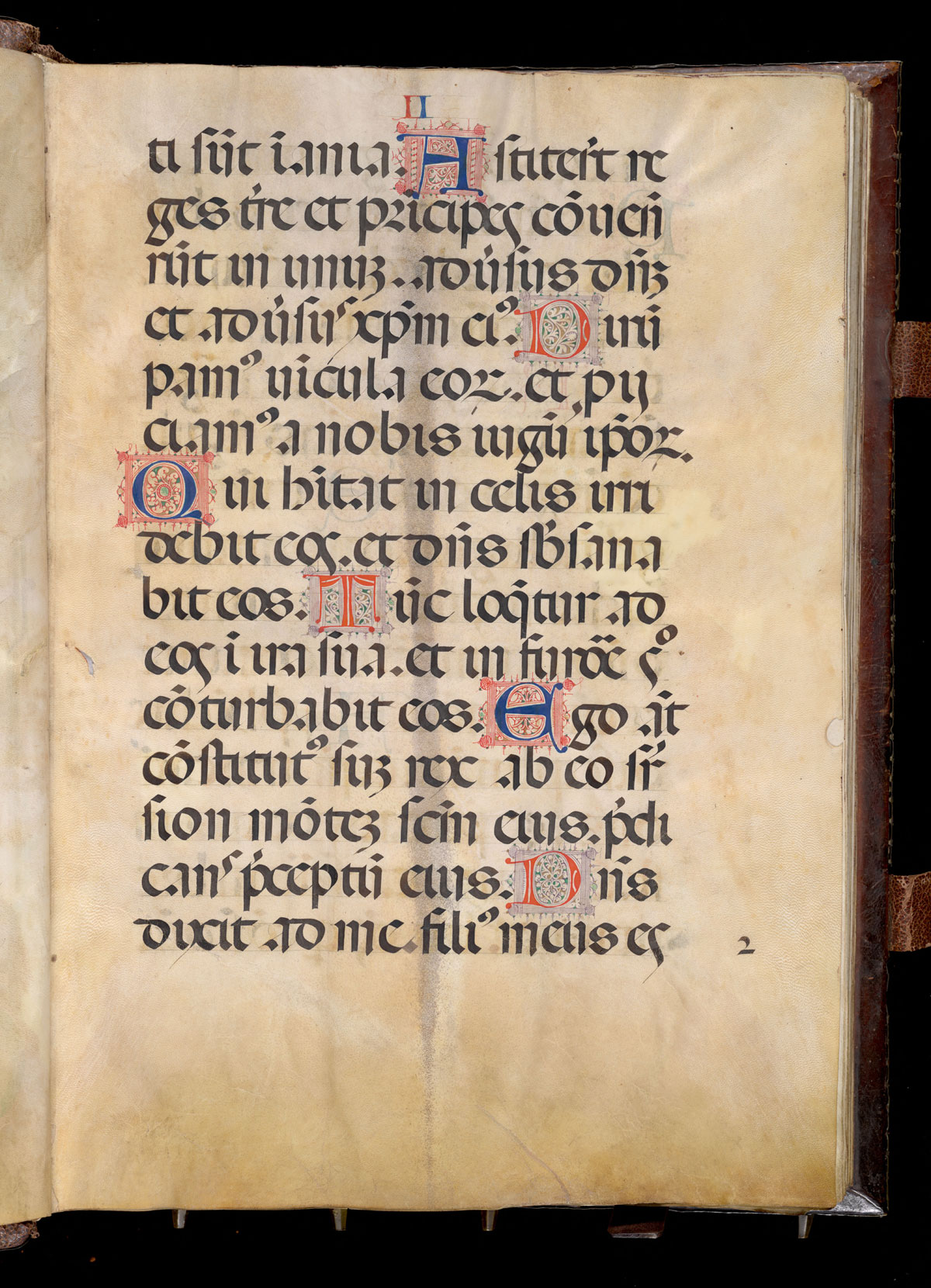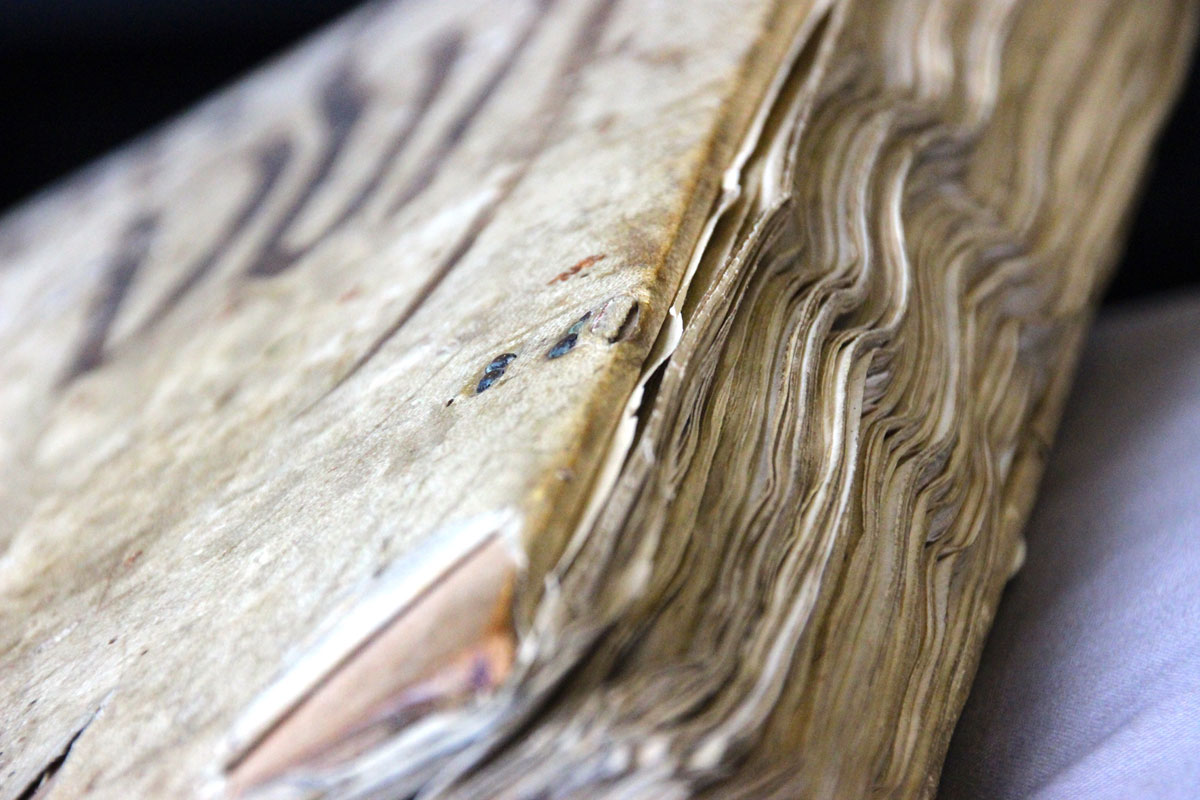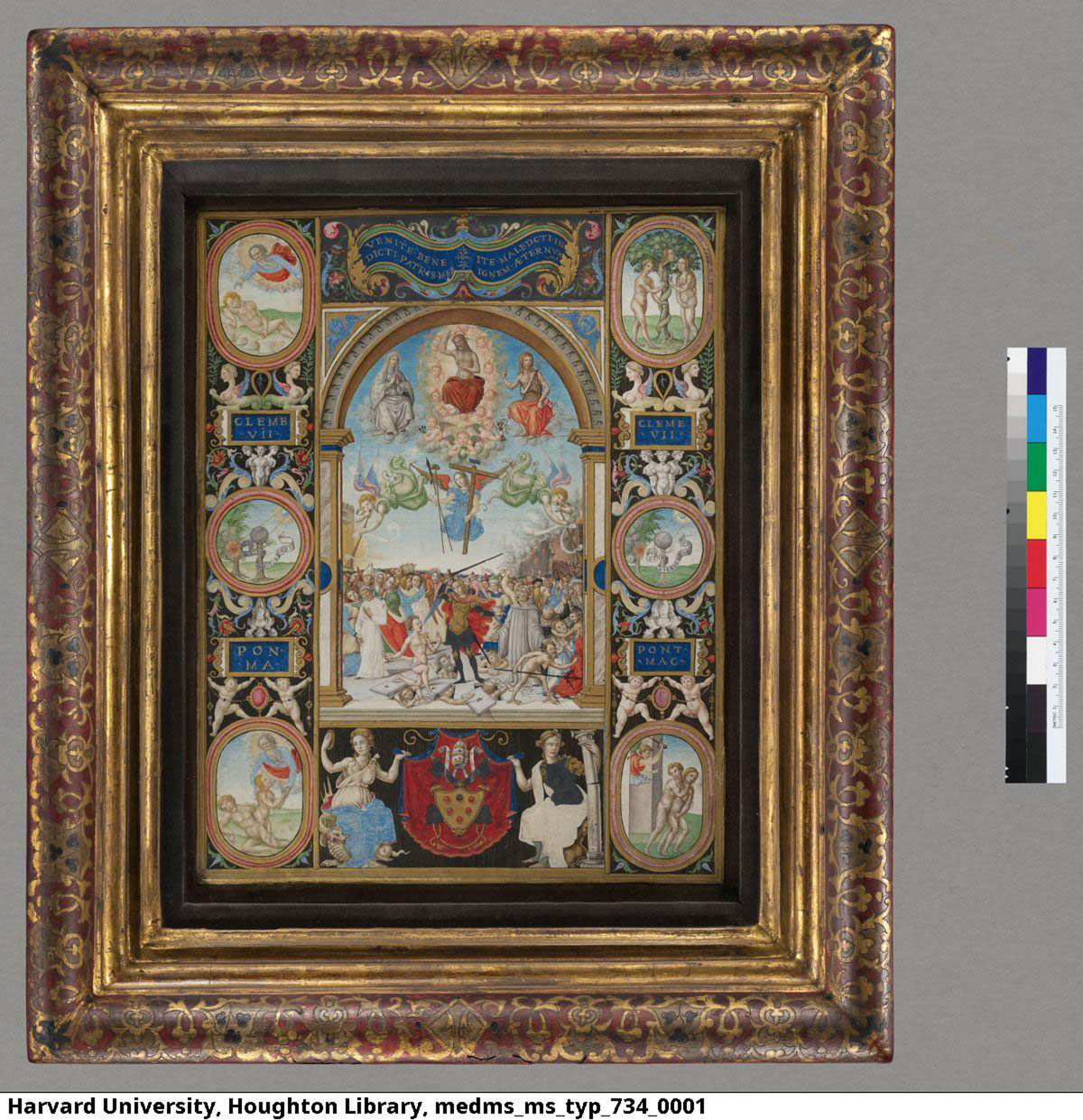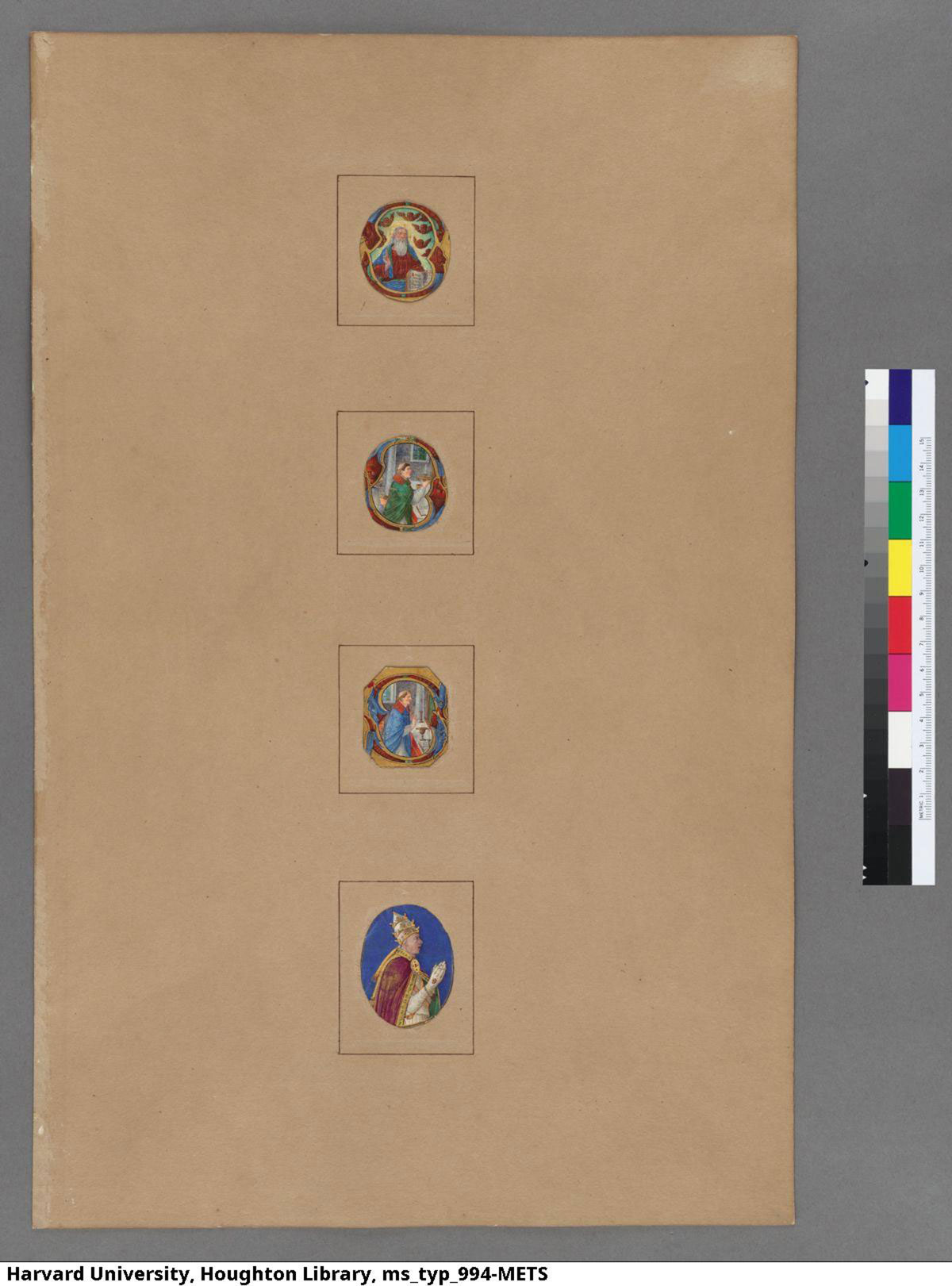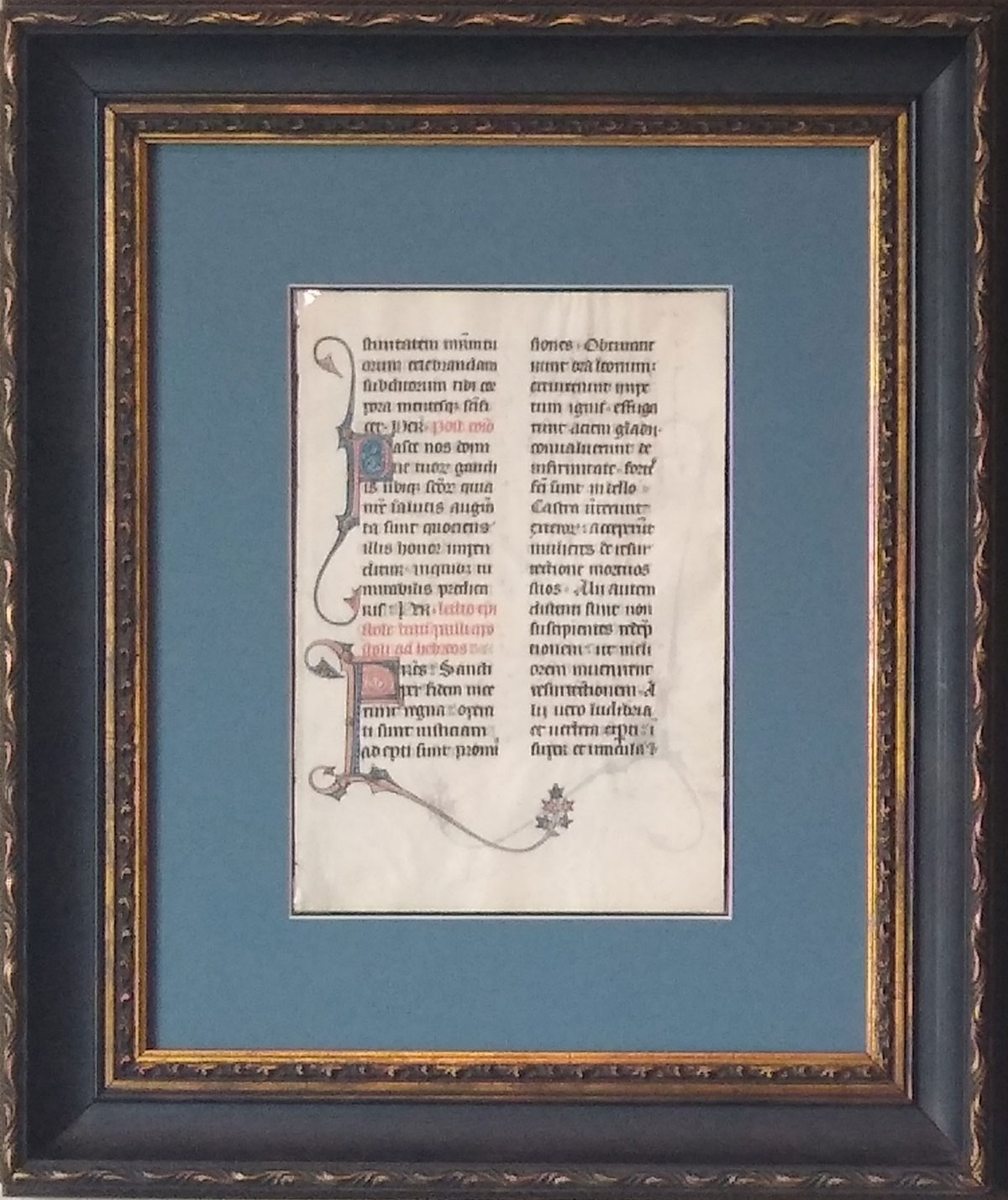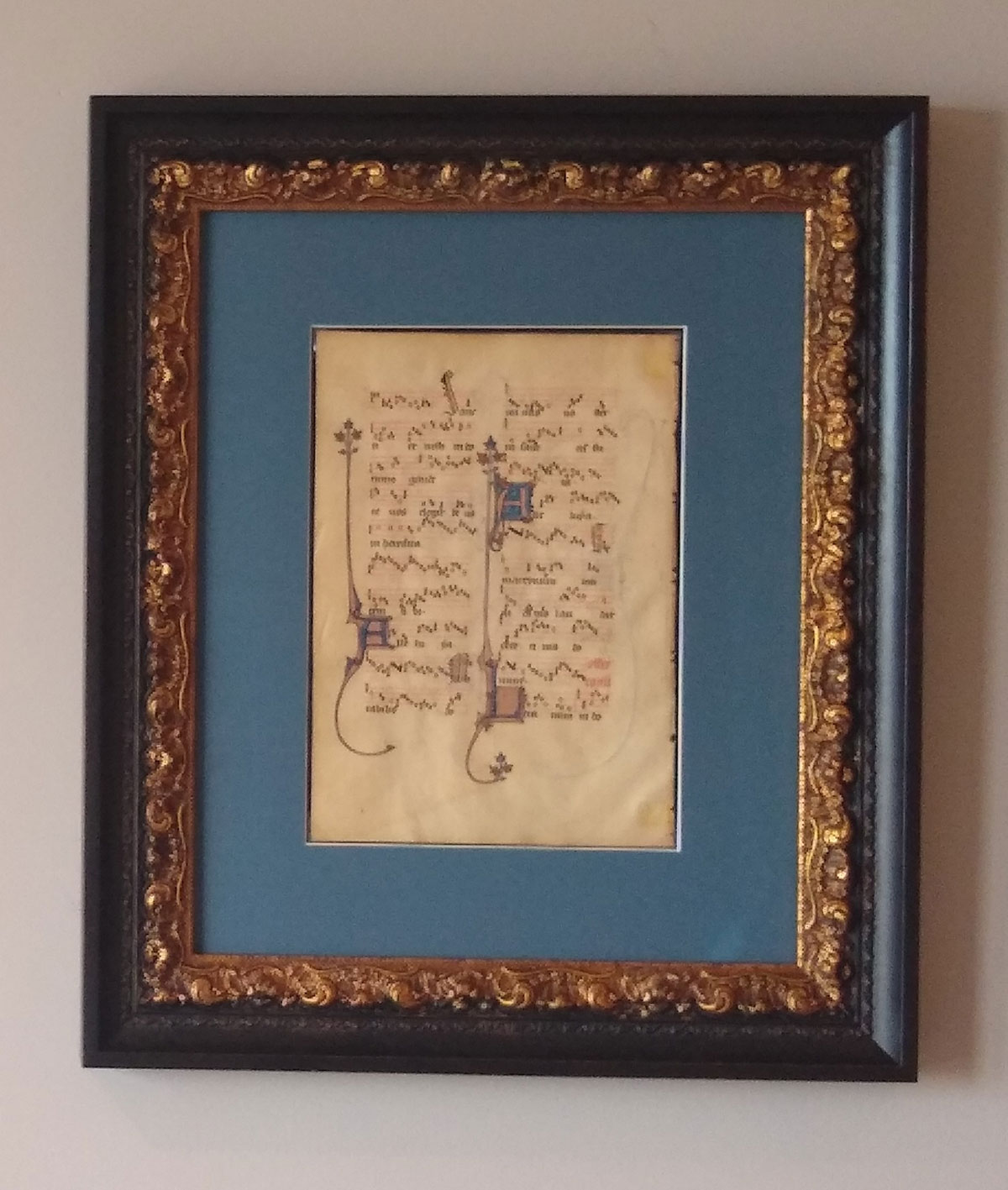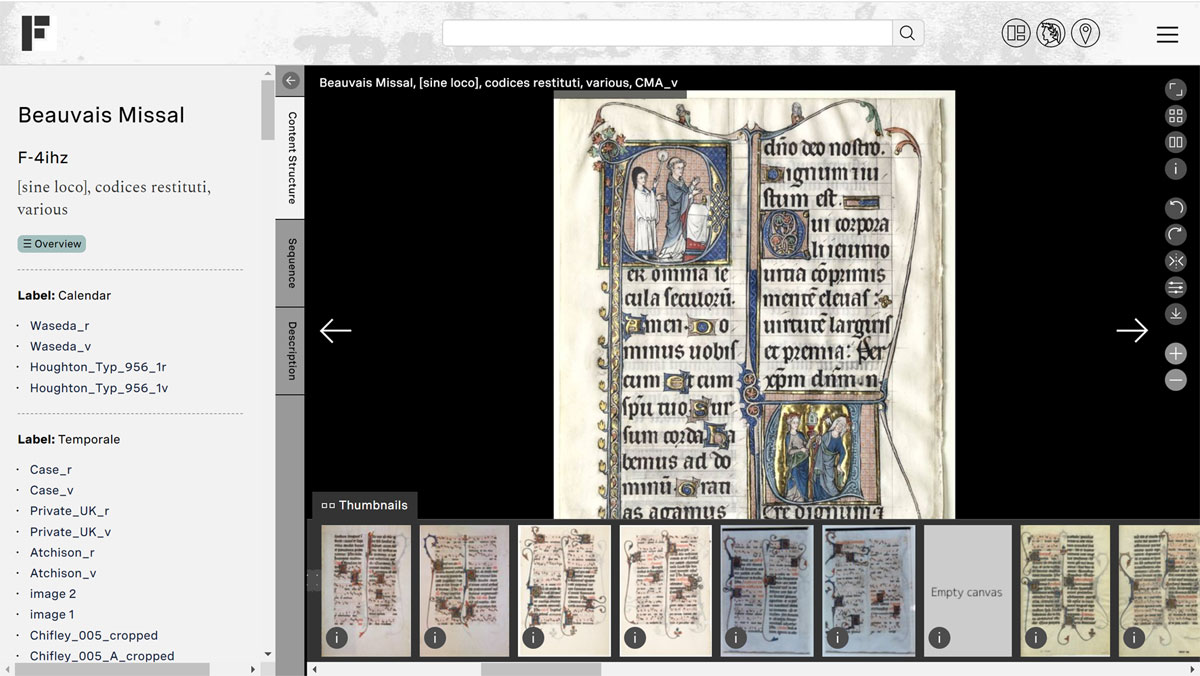1. Introduction
§ 1 This essay will explore the life cycle of a medieval manuscript leaf, from its animal origins to its digital instantiation, in the context of material and ontological “framing.” In particular, I will consider how modern biblioclasm and digital resequencing allow for the application of art-historical framing theory to the multiple transformations a parchment leaf may experience.
§ 2 In the 1996 collection The Rhetoric of the Frame: Essays on the Boundaries of the Artwork (edited by Paul Duro), the authors consider framing theory from different perspectives: historical, curatorial, connoisseurial, colonial (Duro 1996). One of the most applicable tenets of framing theory is summarized by Louis Marin in his contribution, “The Frame of Representation and Some of its Figures,” in which he notes that “the frame renders the work autonomous in visible space” (Marin 1996, 82). Pushing this idea further while writing about framing and display practices in the nineteenth-century museum, Alison Wright argues that “the frames applied by collectors and museums disguised the fragmentary and frequently damaged state of the works they enclosed” (Wright 2019, 15). This idea can be profitably applied to the history and display of manuscript fragments, where the violence of their dismemberment is tidied by enclosure, their fragmentary state disguised by an illusion of completeness.
§ 3 Manuscript leaves undergo multiple types of “framing” as they journey from their medieval haptic origins to the modern digital realm, experiencing the “frame” in all its manifestations: both the internal support and the external boundary. A parchment leaf begins as the hide on an animal’s skeletal framework, a fleshly origin whose shape is permanently imprinted on the folio. The flayed hide is then stretched on a parchmenter’s frame for scudding and preparation for trimming and writing. The book’s binding is a frame-like container that holds the leaf and provides its three-dimensional spatial boundaries. If a manuscript is dismembered, the leaf may find itself contained not in a binding but in a matte, the matte then framed for presentation on a wall. As we move into a digital space, images must have a boundary to manifest the underlying code and they must be presented and contained within the frame of a viewer. What can we make of these various transformations and the frames that support, contain, and constrain them?
§ 4 Dictionary.com defines the noun “frame” as:
a border or case for enclosing a picture, mirror, etc.
a rigid structure formed of relatively slender pieces, joined to surround sizable empty spaces or nonstructural panels, and generally used as a major support in building or engineering works, machinery, furniture, etc.
The word “frame” is therefore a contranym, a word whose various meanings are in fact opposites. A “frame” may be an external boundary or an internal support. It is the latter definition that provides our starting point.
2. The fleshly framework
§ 5 Whether used for codices, documents, Mezuzzah scrolls, charms, binding support, or a wrapper for a piece of fish at an open-air market, all pieces of parchment begin their existence the same way, as the hide of a living, breathing animal. The hide covers the flesh and bones, and it is that skeletal frame that establishes the contours of the hide.
§ 6 The process of transforming the skin from the animal’s protective covering to the pages of a medieval manuscript is brutal and gruesome. As the anonymous riddler of the Exeter Book put it (here in Bruce Holsinger’s new translation): “My enemy, a fiendish man, ripped me from my life. Once I was dead, he threw me in a tub of water. Then he took me out, stretched me in the sun, and left me there. I lost all my hair as his knife cut into me and thereby scraped me clean of my filth and infirmity” (Holsinger 2023, 179).
§ 7 The transformation of the hide from skin to writing surface is an act of violence – the riddler uses verbs like rip, throw, stretch, cut, and scrape. Underlying this violence, literally, is the skeletal framework of the skin, a framework that leaves permanent traces on the finished parchment. As Bruce Holsinger elucidates in his new monograph On Parchment, “Membrane books and documents will often retain the kinetic and emotional force of the animals from which they were rendered and made, just as they preserve the shapes, fibers, odors, and blemishes of their donors’ hides” (Holsinger 2023, 3–4). Such shadows of the skeletal framework are most obvious in the single-skin sheets of giant late-medieval choirbooks such as the oversize example belonging to the Boston Public Library where the spinal column is clearly visible, surviving forever as a ghostly remnant of the animal’s frame (Figure 1). Holsinger again: “Against the beauty of the illuminated initial and the expense of the gold leaf, the imprint of spine follicles evoke the corporeality of such massive books. At each turn of the page, the drape may betray a skeletal axis by flopping over at the spine of the rendered beast” (Holsinger 2023, 81). Alongside the traces of hair and muscle, such ghosts remind us of the animalistic origins of the substrate. The skeletal framework sets the stage for everything still to come.
Boston, Boston Public Library, MS pf Med. 97, f. 5r.
3. In which the parchmenter takes a hand
§ 8 After the hide has been flayed, dehaired, and soaked in lime, the parchmenter takes over. The skin must be stretched and scraped, stretched and scraped again, until it reaches the ideal texture, until it is thin and supple. Here we encounter the frame in its external sense, a boundary or border providing enclosure and containment. The prepared skin is mounted within a wooden frame, attached by cords to pegs that can be tightened to slowly stretch the skin. The frame holds the skin in place, containing it and securing it. This procedure has been used for centuries, as illustrated in the well-known twelfth-century manuscript from Michelsberg (Figure 2).
Bamberg, Staatsbibliothek Bamberg, Msc. Patr. 5, f. 1v detail.
§ 9 This external frame functions in near opposition to the internal skeletal framework. On the living animal, the hide expands because the underlying bones grow, from the initial skin of a newborn calf or lamb to the fully-grown hide of a cow or sheep. The skin expands outwards into the wide world, limited only by the eventual size of the adult animal. The parchmenter’s frame, on the other hand, is finite. The skin stretches to meet it, as the frame defines the ultimate possible extent of the hide’s area. No matter how much the skin is stretched, it cannot extend beyond the boundaries defined by the dimensions of the frame. The skin contained the skeleton; the frame contains the skin.
4. Bound and bounded
§ 10 The skin thus far has been framed from within and without. Most would likely see what comes next as the most important part of the process: the skin is cut into bifolia, ruled, written, and illustrated. For the purposes of a discussion of frames and framing, however, we will jump forward in time to consider the finished book. At this point, a new boundary, a new container, is applied to the completed manuscript. As the Exeter riddler hints, “He dressed me then with boards, and wrapped me in the skin of another, and decked me out in gold and in the finery of smiths” (Holsinger 2023, 179). The vocabulary of violence has given way to adornment: the parchment quires are dressed, wrapped (in skin, no less), and covered in jewels.
§ 11 In English terminology, the finished book is “bound” and “covered.” It is no coincidence that those words are synonymous with the work of a frame, but here bounded along three axes instead of two. The binding of a book defines its spatial boundaries, the covers its ultimate extent. Like the parchmenter’s frame, the bookbinding contains and constrains. And yet even here we sometimes see the parchment pushing to return to the shape of the animal, cockling, curling, expanding, and threatening to burst its constraints (Figure 3). Straps and clasps can be helpful in such situations, battening the hatches and enforcing spatial boundaries.
5. Illusory autonomy
§ 12 Everything thus far has been prologue, as we made our way from the animal to the bound codex. It is the transformation from whole codex to fragment and beyond – and the ensuing frames, frameworks, and framing – that will be my subject for the remainder of this essay.
§ 13 There are essentially four types of manuscript fragments: 1) parchment remnants used for everyday purposes such as wrapping fish at the market; 2) bespoke bits used for binding supports in the late Middle Ages and early modern period; 3) cropped initials sourced by early modern antiquarians; and 4) whole single leaves from manuscripts dismembered by modern biblioclasts. Only two of these four categories are generally candidates for framing and thus relevant for my subject: initial cuttings, and single leaves (throughout this essay, the descriptor “single leaves” refers to leaves that have been removed from a codex in the modern or early modern period for resale, as opposed to single sheets that were created for use outside of a codex, such as archival documents, independent miniatures, correspondence, or indentures.) This phase of fragmentation begins in the eighteenth century, as manuscripts begin to be cut up “for pleasure and profit,” as Christopher de Hamel puts it (De Hamel 1995, see also Davis 2022). Bibliophiles such as Sir Robert Cotton or Archbishop Matthew Parker are known to have disassembled duplicate or unwanted manuscripts, reusing and reframing bits and pieces (Reynolds 2017). The practice becomes widespread with the Gothic revival of the late eighteenth century and the increasing interest in collecting and studying antiquities into the nineteenth century, when medieval manuscripts become prized as ancient artifacts and examples of artistry. Many collectors were more interested in the art than the text, and dealers and owners alike developed a habit of cutting out initials and miniatures, leaving behind spoliated carcasses like empty frames. This practice resulted in sales and collections of free-standing tightly-cropped initials and miniatures, arranged cuttings (often adhered to highly acidic paper), and elaborate collages. The French Revolution and its aftermath provided a previously-unimaginable opportunity, as religious communities throughout the French-occupied territories were plundered, the masterpieces of late medieval and Renaissance art preserved in their giant elaborate choirbooks ripe for the cutting. For example, the series of volumes created for the use of Pope Clement VII were stolen from the Sistine Chapel in 1798, and Luigi Celotti (1759–1843) has been held responsible for their desecration by cutting. Elaborate collages such as that preserved as Harvard University, Houghton Library MS Typ 734 were the result (Figure 4).
§ 14 The cutting of initials and miniatures accelerated throughout the nineteenth century to such an extent that, on 3 January 1854, John Ruskin could famously and casually journal, “Gave Sophy a walk, not much else done except for myself. Today in at Mr. Melville’s. Wrote bit of chapter on mountains. Cut missal up in evening — hard work — read some of Wilkinson’s Egypt” (Evans and Whitehouse 1958, 487). Collectors on the American side of the Atlantic begin to demonstrate an interest in such cuttings and albums beginning in the mid-nineteenth century, and the results of their scissorly labour can now be found in collections on both sides of the ocean.
§ 15 What are we to make of these tiny works of art, cut, cropped, adhered, mounted, and framed? Art-historical frame theory can help us unpack the ramifications of the decontextualized framed initial on the one hand and the “re”-contextualized framed collage on the other.
§ 16 Consider Harvard University, Houghton Library MS Typ 994, four initials painted in late fifteenth-century Italy, cut from their parent codex in the early modern period, trimmed to consistent size and shape, and currently adhered together to a single thick acidic matte (Figure 5).
In the case of Typ 994, the four miniatures are presented as a unified collection, presumably, but not definitively, taken from the same source manuscript. The initials are closely cropped. Because they are pasted on the surface of the matte, the dorse of the initials cannot be seen. We cannot know what, if any, textual evidence may have been preserved on the non-visible sides. We cannot know which side of each cutting was in fact the recto or the verso. We cannot know their liturgical context, and we cannot identify the subject of each initial. The iconography is too generic. We cannot even know what letters they originally represented. In other words, the act of cutting and pasting has left these initials utterly decontextualized. All meaning has been stripped away, leaving the miniatures as simple, tiny, lovely works of art. Would the casual viewer even know their story, cleanly trimmed and matted as they are? Probably not. This is what Wright means when she observes: “The museum frame, in presenting a work as complete, and at home in public view, frames out the intervening history of cultural uprooting and shaping to the needs of collectors and the art market” (Wright 2019, 15). Regarding Typ 994, the framing implied by the matte, the supplied boundary, renders these works autonomous. The four tiny paintings are presented as complete in and of themselves, with no hint, no record, of their violent origins at the hands of a cutter like John Ruskin. This implied autonomy, however, is entirely illusory.
§ 17 The idea of the boundary represented by a frame serving to imply autonomy and completeness where perhaps none exists is magnified in the case of collages such as Houghton Typ 734, created by Celotti in the wake of the Napoleonic looting of the Vatican in 1798 (Figure 4). With these collages, cuttings have been not only trimmed and adhered, but they have also been given a new context alongside their sisters, transformed into a new work of art and constrained within a custom frame with architectural elements. This is suggestive of the nineteenth-century archaeological curatorial practice of arranging sculptural fragments in bounded tableaux that present a narrative or content that may very well have had absolutely nothing to do with the antecedent artwork in its original archaeological context. Referring to an early display of the Aegina Marbles in Munich, which incorporated numerous silent and sometimes jarring interventions, Wolfgang Ernst wrote:
“The nondiscursive character of archaeological depositories and inventories is turned into figurative, often fantastic entities by narrative will. Dismembered fragments are abused for the sake of historical imagination by subjecting them to a narrative frame, replacing the evidence of decomposition by anthropomorphic hallucinations…reassembling the fragments into monstrous configurations.” (Ernst 1996, 118)
“Abused,” “hallucination,” and “monstrous” may perhaps be excessive descriptors to apply to Celotti’s collages, but the principle holds.
§ 18 With the naked eye, it is extremely difficult to discern how many puzzle pieces make up Typ 734. By zooming in on the high-resolution digital image on the Houghton website, however, we can indeed make out the joins. The mosaic is made up of four distinct cuttings: a miniature of the last judgment; an upper banner with the text of Matthew 25.34 and 41; an L-shaped piece with three medallions on the left – Adam and Eve at top and bottom and a central emblematic medallion that names Pope Clement VII – conjoined with a composition at the bottom that includes the papal Medici arms; and a matching side piece on the right with three similar medallions. The collage is glazed and housed in an early, ornate gilt wooden frame. Like the four cuttings previously examined, the collage is comprised of decorative elements cut from a giant elaborate choirbook. Like the four cuttings, the pieces that make up Typ 734 are utterly decontextualized.
§ 19 Unlike the four cuttings, which are presented simply as themselves, stripped down and autonomous, but very much like the Aegina Marbles, the cuttings which comprise Typ 734 have been re-contextualized, the membra disjecta Frankensteined into something new. The frame is there to keep the pieces from flying apart, to constrain them in their new positions and to give the impression that this collage is a whole and autonomous work of art. The frame completes the process of erasure, obliterating the collage’s history of looting and violence.
§ 20 Now we turn to the uncropped, disbound, whole single leaf. The rise of capitalist antiquarianism in the late nineteenth and early twentieth centuries impacted the rare book and manuscript trade in ways that would have long-term implications for the selling and buying of manuscript fragments, especially in North America. In addition to trimmed cuttings and albums of binding fragments or miniatures, whole single leaves begin to appear on the market with increasing frequency. Booksellers came to the realization that they would make a lot more money if they broke manuscripts apart, selling 250 single leaves to 250 buyers instead of one book to one buyer. As de Hamel puts it,
This marks the crucial turning point in our story. Early nineteenth-century collectors were interested only in isolated illuminations. Miniatures were cut out and the vandalized text pages were frankly destroyed. But by the first decade of the twentieth century –not much earlier– all parts of a dismembered manuscript became collectable. When this happened, as you would expect, the antiquarian booktrade obligingly changed gear. Booksellers began breaking manuscripts, to sell leaf by leaf by leaf. (De Hamel 1996, 15)
§ 21 The Americans had caught on to this capitalist economy-of-scale by the 1920s or so and began gleefully breaking books and selling them off page by page. What dealers broke, collectors bought. The United States, with its new industry-fueled wealth, was a primary beneficiary of this flooded market. From Masters of Industry to small-town collectors, major museums to small colleges, bibliophiles in the United States were clamoring for matted and framed leaves, in particular leaves from Gothic Books of Hours and Italian choirbooks. Today, there are tens of thousands of leaves from thousands of dismembered manuscripts in hundreds of North American collections (see Conway and Davis 2013).
§ 22 Consider the leaf reproduced in Figure 6, dismembered, matted, framed, and hanging on the wall of the author’s home office. Like the cuttings and the collages, it has been violently removed from its original codicological context and magicked into a solitary and autonomous work of art, encapsulated and defined as whole by its matte and frame. As far as the casual viewer is concerned, the leaf’s origins are utterly unknown and not of particular interest. From the paleographer, art historian, or liturgist, however, the leaf demands to know: When and where was I written? What am I? Considering just this single out-of-context leaf, one might (correctly) deduce that the manuscript was written in late thirteenth-century France, based on paleographic and stylistic evidence. One might also (and incorrectly) conclude that it was likely part of a lectionary or evangeliary, based on the contents. To truly understand what this is, the leaf must be considered alongside other leaves from the same manuscript in order to discern its contents and its history. The autonomy seemingly bestowed by the frame is, once again, illusory.
§ 23 If we expand our horizon beyond the containment of the frame, we find another leaf of similar style and dimensions, a second leaf from the same parent manuscript (Figure 7). This framed folio also gives the illusion of autonomy until it is considered alongside its sister. Alone, this second leaf appears to be a gradual, containing nothing but chants for Mass. Consider them side by side, though, and a new story begins to take shape. It is only by breaking the boundaries of the frame to consider multiple leaves in the world defined by these membra disjecta that the details come into focus. In fact, as we start to add to the corpus of leaves pulled from this codex, the cumulative evidence allows us to see the parent manuscript for what it was, a late thirteenth-century Missal for the Use of Beauvais.
§ 24 In October of 1942, New York auction house Gimbel Brothers sold what is now known as The Beauvais Missal on behalf of the volume’s owner, William Randolph Hearst (Kidd 2014). The buyer was a New York bookdealer named Philip Duschnes, who promptly cut the manuscript apart. Duschnes counted among his friends and business associates Cleveland bookdealer Otto F. Ege, who was among the most prolific of the twentieth-century American biblioclasts. Ege spent most of his career as a professor of art history at the Cleveland Museum of Art and at Case Western Reserve University in Ohio (for a detailed study of Ege’s biblioclasm and career, see Gwara 2013). He was a collector of manuscripts, but he was also a bookdealer, best known for breaking apart manuscripts and early printed books in the 1930s and 1940s and selling them leaf by leaf at a massive profit. Ege defended his “biblioclasm” with what he considered the noble goal of putting a little bit of the Middle Ages within the economic grasp of even the humblest collector or smallest institution. In a 1938 article in a “hobbyist” journal called Avocations, Ege explained:
“Book-tearers have been cursed and condemned, but have they ever been praised or justified?...Surely to allow a thousand people ‘to have and to hold’ an original manuscript leaf, and to get the thrill and understanding that comes only from actual and frequent contact with these art heritages, is justification enough for the scattering of fragments. Few, indeed, can hope to own a complete manuscript book; hundreds, however, may own a leaf.” (Ege 1938, 517–518)
§ 25 Ege’s actions were certainly misguided, but he was correct in one important respect; small collections throughout the United States that could never have afforded to buy entire codices are the proud possessors of significant teaching collections of medieval manuscript leaves. Today, several thousand leaves from several hundred manuscripts that passed through Ege’s hands can be identified in at least 115 North American collections in 25 states. According to the Directory of Collections in the United States and Canada with Pre-1600 Manuscript Holdings, the number of fragments in North America is around 30,000; in other words, more than 10% of the entire corpus of single leaves in the United States can be traced back to Otto Ege (Conway and Davis 2015, 274).
§ 26 Ege and his wife Louise used the leaves of several dozen manuscripts to create thematic “portfolios” for sale. In other words, they would take one leaf of this manuscript, one leaf of that one, one leaf from a third, and so on, and pile them up into a deck of manuscript leaves, each of which was from a different codex. The most common of these portfolios are titled “Fifty Original Leaves from Medieval Manuscripts”; “Original Leaves from Famous Bibles”; and “Original Leaves from Famous Books.” The leaves were taped into custom mattes with a distinctive red-fillet border and the Ege’s handwritten notes across the bottom, identified with Ege’s letterpress label, and stored in custom buckram boxes. Because the leaves in these portfolios are always sequenced the same way, Number 5 in one portfolio comes from the same manuscript as Number 5 in every other portfolio of the same name. There were forty (perhaps forty-one) such boxes titled “Fifty Original Leaves of Medieval Manuscripts,” of which thirty-two have been located: to the twenty-nine sets recorded by Gwara (106–107) may be added Set No. 3 (the Ege Family’s personal portfolio)—acquired from Otto and Louise Ege’s grandchildren by the Beinecke Rare Book & Manuscript Library in 2015 (shelfmark TBD); Set No. 1—found in a basement in Ohio in 2020, auctioned at Christie’s London on 8 December 2020, lot 9, and acquired by the Houghton Library at Harvard University (MS Typ 1294); and Set No. 18, offered (but unsold) at Christie’s London on 14 December 2022, lot 19. In those thirty-two boxes are thirty-two leaves from each of those fifty manuscripts, including no. 15, the Beauvais Missal. The Ege portfolios therefore represent a coherent – and intrinsically American – corpus of leaves that can be affiliated with a discreet number of manuscripts, leading to the realistic possibility of the recovery and study of at least a portion of many of these codices, including the Beauvais Missal (for more about the Beauvais Missal, see Davis 2016; Davis 2023; Davis forthcoming) The leaves of such dismembered manuscripts are so scattered, however, that it is essentially impossible to physically collect them in the haptic world. Digital imaging offers a way forward.
6. Manifestation
§ 27 According to Encyclopedia.com:
A digital image is a representation of a real image as a set of numbers that can be stored and handled by a digital computer. In order to translate the image into numbers, it is divided into small areas called pixels (picture elements). For each pixel, the imaging device records a number, or a small set of numbers, that describe some property of this pixel, such as its brightness (the intensity of the light) or its color. The numbers are arranged in an array of rows and columns that correspond to the vertical and horizontal positions of the pixels in the image.
§ 28 The image viewer transforms the code in each pixel into a particular colour, a combination of red, green, and blue in various degrees. The screen emits the pixels’ colours as light waves that can be received and interpreted by the human eye. In order to accomplish this trick, the code must be embedded in a viewer, a container, as it were, that sets the boundaries of the image, constraining it in digital space. Otherwise, it’s just drifting code.
§ 29 José Ortega y Gasset described this very phenomenon in 1943, writing about the implications of an unframed work of art: “Its content overflows the edges of the canvas and dissolves in the surrounding reality…. The relationship between frame and painting is quite indissoluble, then, and far from being accidental; it has the nature of being a physical law” (Ortega y Gasset [repr] [1943] 1990, 187). In the case of digital images, the container, boundary, or frame, if you will, is in fact a physical law, as the image cannot manifest in a human-readable way without it.
§ 30 When a single side of a single leaf, in particular, is subject to this digital transformation, it gains a new, virtual boundary within which it is displayed and constrained. What if that leaf was already matted and framed? Then we find ourselves gazing at three concentric borders, matte, frame, and digital. Often, best-practices for imaging works of art call for capturing the art unframed or for removing the frame in post-processing. On the Louvre website, for example, La Joconde is imaged both within and without her frame (“La Joconde” 2023). The difference is rather jarring. The framed version immediately expands the distance between the viewer and the art, transporting us to the Salle des États in Paris, dodging the crowds to view the painting from afar. We are distant, separate, watching from outside the window. Though bound within the implied but invisible borders of the digital viewer, without the wooden frame she is present and immediate.
§ 31 In much the same way, there is a real perceptual difference between an image of the framed leaf on the author’s wall and one in which the matte and frame have been cropped out (Figures 6 and 8). In the frame, the leaf stands alone, seemingly complete and autonomous, a work of art hanging on the wall. We can clearly intuit what lies beyond those boundaries – the flat surface of a wall. Frameless, the leaf is manifested within the boundaries imposed by the necessary viewer. It no longer displays itself as a work of art on a wall, vertically mounted, separate and alone. The observer cannot discern what lies beyond the boundaries of the image. In digital space, we know the answer is literally “nothing.” Because there is no haptic frame in view, however, we can set aside the solitude of the dismembered leaf, separated from its sisters forever. Ask again: What lies beyond the boundaries imposed by the viewer? Perhaps the answer is “anything.” Floating in digital space, the manifestation is aglow with potentiality.
7.Narrativity
§ 32 In his 1996 essay, “The Narrative of the Frame,” Wolfgang Kemp engages with the idea that each component of a celluloid filmstrip is called a “frame” (Kemp 1996). Each frame of a filmstrip is indeed a miniature work of art, emulsified, bordered, and bounded. The usage is common to many languages, as in cadre de filme, or Filmrahmen. When the bordered images are run before a light source in the correct sequence, they create a projected moving picture. The frames come together in a sequence to add movement and narrativity to otherwise static images, each frame in its proper place.
§ 33 From front to back, every book tells a story. Every book, whether fiction or non-fiction, single work or compilation, is a narrative. The same holds for film. It should come as no surprise, then, that the sequence of thumbnail images that run across the bottom or side of a digital image viewer such as Mirador or OpenSeaDragon is often referred to as a “filmstrip.” Navigating this filmstrip of miniature images allows the user to quickly and easily make their way through the digitized codex. Like a filmstrip, then, a digitized codex is a sequence of images placed in a particular order predetermined by the author, scribe, compiler, or owner to build an argument, to make a case, to tell a story, or, in the case of a liturgical manuscript like the Beauvais Missal, to record the liturgy of the year in a chronological sequence, in liturgical narrative. From beginning to end, a digitized codex – as embodied in its thumbnail filmstrip – is imbued with narrativity.
§ 34 It is this built-in frame-by-frame narrativity that provides us with an opportunity to rebuild dismembered codices in digital space. In the early years of the twenty-first century, scholars began to realize the potential of burgeoning digital technologies for the virtual reconstruction of dismembered manuscripts, in particular those manuscripts dismembered by Ege. In 2003, Barbara Shailor issued the first call to arms:
For Otto Ege fragments now dispersed around the world, the possibilities presented by modern technology are fascinating. It is only a matter of time, financial resources, and scholarly communication and perseverance before significant portions of Ege’s intriguing collection will be reassembled and made available electronically. (Shailor 2003, 22)
§ 35 Shailor was absolutely right. The development of the International Image Interoperability Framework (IIIF) in the 2010s signaled the beginning of this next phase of the study of medieval manuscript fragments: Digital Fragmentology. The International Image Interoperability Framework is a way of presenting digital images in an online environment that allows them to be shared via a persistent URL instead of by downloading and uploading into a silo (for technical details, see http://iiif.io). The underlying code (the “manifest”) includes metadata that travels with the image, metadata that can be updated and expanded by the holding institution at any time. If an online image is IIIF-compliant, it can be manifested in a workspace known as a “shared canvas” simply by pointing to the IIIF manifest URL. The image file and the associated metadata encoded in the manifest are drawn into the shared canvas when called for rather than being physically stored there. This interoperability has the advantage of enabling a user to apply annotations and sequence images without transforming the actual image files or manifests. An image can be stored in one place while being used in multiple workspaces. The model is completely open-access and avoids siloing and is thus in keeping with digital best practices. For fragmentological research, this means that a fragment from one collection can be mirrored into a shared-canvas viewer alongside sister fragments from other institutions, digitally resequencing the dismembered parent manuscript with no need for rekeying data or siloing images. Interoperability is the key to Digital Fragmentology.
§ 36 To make this happen, we need the right tools, such as a data- and image-bank that would facilitate fragment-centric data modeling and shared-canvas interoperability. Fortunately, such a tool exists: Fragmentarium.ms (https://fragmentarium.ms/). Fragmentarium is a fragment-centric database and imagebank that takes advantage of IIIF functionality to easily allow users to upload, catalogue, and arrange leaves to create digital sequences. Individual fragments each have their own records, and those records can then be combined in sequence to create reconstructions. The data and images of the 122 leaves of the Beauvais Missal that the author has accumulated are now available in the Fragmentarium platform, taking advantage of the site’s IIIF functionality to sequence the known leaves into a virtual reconstruction that combines discoverable metadata with image scrolling, and provides metadata at leaf and sequence level (Davis 2019).
§ 37 In the sequence, each image is manifested in its individual canvas, with its individual metadata, bounded by the edges of the space. The images in sequence sit within a larger viewer with its own sequence-level metadata, rebuilding and describing the broken codex – as much as possible – in the digital space. Finally, the sequence of thumbnail frames is arranged in a filmstrip across the bottom of the viewer (Figure 9). By sequencing framed, bound digital images, digital fragmentology restores the narrativity of the original codex.
Resequence of the Beauvais Missal in Fragmentarium (https://fragmentarium.ms/overview/F-4ihz, screenshot).
§ 38 But this resequencing can, at best, result only in a simulacrum. The Beauvais Missal, like so many other victims of biblioclasm, can no longer exist in the haptic world. To quote philosopher Martin Heidegger: “World-withdrawal and world-decay can never be undone. The works are no longer the works they were. It is they themselves, to be sure, that we encounter there, but they themselves are gone by” (Heidegger 1971, 40).
Competing Interests
The author has no competing interests to declare.
Contributions
Recommending editors
N. Kıvılcım Yavuz, University of Leeds, UK
Katarzyna Anna Kapitan, University of Oxford, UK
Recommending referees
Agnieszka Backman, Uppsala University, SE
Debra Cashion, Saint Louis University, USA
Section Editor/Chief Copy and Layout Editor
Morgan Pearce, The Journal Incubator, University of Lethbridge, Canada
References
Primary Sources
Boston, Boston Public Library, MS pf Med. 97
Bamberg, Staatsbibliothek Bamberg, Msc. Patr. 5
Secondary Sources
Conway, Melissa, and Lisa Fagin Davis. 2013. “The Directory of Institutions in the United States and Canada with Pre-1600 Manuscript Holdings: From its Origins to the Present, and its Role in Tracking the Migration of Manuscripts in North American Repositories.” Manuscripta 57(2): 165–181. Accessed November 2, 2023. https://www.journals.uchicago.edu/doi/full/10.1086/682342.
Conway, Melissa, and Lisa Fagin Davis. 2015. “Directory of Collections in the United States and Canada with Pre-1600 Manuscript Holdings.” Papers of the Bibliographical Society of America 109(3): 273–420. Accessed November 2, 2023. http://www.journals.uchicago.edu/toc/pbsa/2015/109/3.
Davis, Lisa Fagin. 2016. “The Beauvais Missal: Otto Ege’s Scattered Leaves and Digital Surrogacy.” Florilegium 33: 143–166. Accessed November 2, 2023. https://journals.lib.unb.ca/index.php/flor/article/view/31194.
Davis, Lisa Fagin. 2022. “An Echo of the Remanent.” Florilegium 35:5–30. Accessed November 2, 2023. https://doi.org/10.3138/flor-2022-0002.
Davis, Lisa Fagin. 2023. “Reconstructing the Beauvais Missal.” Accessed November 2. https://brokenbooks2.omeka.net.
Davis, Lisa Fagin. Forthcoming. “Resequencing the Beauvais Missal.” Digital Philology 13.
Davis, Lisa Fagin, ed. 2019. “Beauvais Missal (Virtual Reconstruction).” fragmentarium.ms. Accessed November 2, 2023. https://fragmentarium.ms/overview/F-4ihz.
De Hamel, Christopher. 1996. Cutting up Manuscripts for Pleasure and Profit: The 1995 Sol. M. Malkin Lecture in Bibliography. Charlottesville, VA: Book Arts Press.
“Digital Images.” 2023. Encyclopedia.com. Accessed November 2. https://www.encyclopedia.com/computing/news-wires-white-papers-and-books/digital-images
Duro, Paul, ed. 1996. The Rhetoric of the Frame: Essays on the Boundaries of the Artwork. Cambridge Studies in New Art History and Criticism. Cambridge (England): Cambridge University Press.
Ege, Otto F. 1938. “I am a Biblioclast.” Avocations: A Magazine of Hobbies and Leisure 1: 516–520.
Ernst, Wolfgang. 1996. “Framing the Fragment: Archaeology, Art, Museum.” In The Rhetoric of the Frame: Essays on the Boundaries of the Artwork, edited by Paul Duro, 111–135. Cambridge (England), New York, NY: Cambridge University Press.
Evans, Joan, and John Howard Whitehouse, eds. 1958. The Diaries of John Ruskin, 1848–1873. Oxford: Clarendon Press.
“Frame.” 2023. Dictionary.com. Accessed November 2. https://www.dictionary.com/browse/frame.
Gwara, Scott. 2013. Otto Ege’s Manuscripts: A Study of Ege’s Manuscript Collections, Portfolios, and Retail Trade, with a Comprehensive Handlist of Manuscripts Collected or Sold. Cayce, SC: De Brailes Publishing.
Heidegger, Martin. 1971. “The Origin of the Work of Art.” In Poetry, Language, Thought. Translated by Albert Hofstadter. New York: Harper and Row.
Holsinger, Bruce. 2023. On Parchment. New Haven, CT: Yale University Press.
Kemp, Wolfgang. 1996. “The Narrative of the Frame.” In The Rhetoric of the Frame: Essays on the Boundaries of the Artwork, edited by Paul Duro, 11–23. Cambridge (England), New York, NY: Cambridge University Press.
Kidd, Peter. 2014. “The Beauvais Missal: A New Piece of the Provenance.” Medieval Manuscripts Provenance (blog), August 2. Accessed November 2, 2023. https://mssprovenance.blogspot.com/2014/08/the-beauvais-missal-new-piece-of.html.
Louvre. 2023. “La Joconde.” Collections. Musée du Louvre and Musée National Eugène-Delacroix. Accessed November 20. https://collections.louvre.fr/en/ark:/53355/cl010066723.
Marin, Louis. 1996. “The Frame of Representation and Some of its Figures.” In The Rhetoric of the Frame: Essays on the Boundaries of the Artwork, edited by Paul Duro, 79–95. Cambridge (England), New York, NY: Cambridge University Press.
Ortega y Gasset, José. [1943] 1990. “Meditations on the Frame.” Perspecta 26: 185–190. Translated by Andrea L. Bell. Accessed November 2, 2023. https://doi.org/10.2307/1567161.
Reynolds, Anna. 2017. “‘Such Dispersive Scattredness’: Early Modern Encounters with Binding Waste.” Journal of the Northern Renaissance 8. Accessed October 29, 2023. http://www.northernrenaissance.org/such-dispersive-scattredness-early-modern-encounters-with-binding-waste/.
Shailor, Barbara. 2003. “Otto Ege: His Manuscript Fragment Collection and the Opportunities Presented by Electronic Technology.” The Journal of the Rutgers University Libraries 60: 1–22. Accessed November 2, 2023. https://doi.org/10.14713/jrul.v60i1.4.
Wright, Alision. 2019. Frame Work: Honour and Ornament in Italian Renaissance Art. New Haven, CT: Yale University Press.

